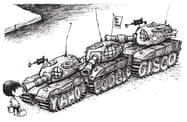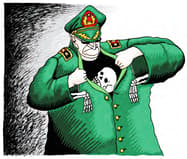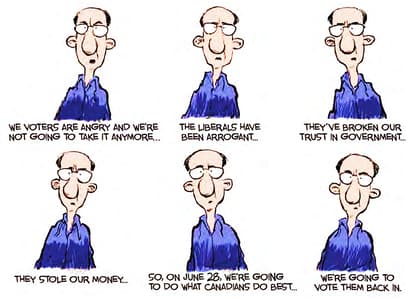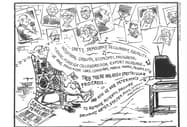
This cartoon symbolises the block by the Chinese government of free flow of information on the Internet by placing restrictions on popular websites like ‘Google’ and ‘Yahoo’. The image of tanks and an unarmed student reminds the reader of another major event in recent Chinese history.
Find out about that event which was similar to this.


Important Questions on What Is Democracy? Why Democracy?
Read these five examples of working or denial of democracy and choose the relevant feature of democracy.
| Example | Feature |
| King of Bhutan has declared that in the future, he will be guided by the advice given to him by elected representatives. | Rule of law |
| Many Tamil workers who migrated from India were not given the right to vote in Sri Lanka. | Respect for Rights |
| The king imposed a ban on political gatherings, demonstrations, and rallies. | One person one vote one value |
| The Indian Supreme Court held that the dissolution of the Bihar assembly was unconstitutional. | Free and fair electoral competition |
| Political parties in Bangladesh have agreed that a neutral government should rule the country at the time of elections. | Major decisions by elected leaders |
This cartoon is from Brazil, a country with a long history of dictatorships. It is entitled “The Hidden Side of Dictatorship”.
a) Which hidden sides does this cartoon depict?
b) Is it necessary for every dictatorship to have a hidden side?
This cartoon was published in Canada just before its parliamentary elections of . Everyone, including the cartoonist, expected the Liberal party to win once again. When the results came, the Liberal Party lost the elections.
Is this cartoon an argument against democracy or for democracy?
Read the given information and answer the following question.
Rajesh and Muzaffar read an article. It showed that no democracy has ever gone to war with another democracy. Wars take place only when one of the two governments is non-democratic. The article said that this was a great merit of democracy. After reading the essay, Rajesh and Muzaffar had different reactions. Rajesh said that this was not a good argument for democracy. It was just a matter of chance. It is possible that future democracies may have wars. Muzaffar said that it could not be a matter of chance. Democracies take decisions in such a way that it reduces the chances of war.
Which of the two positions do you agree with and why?
This famous cartoon by R. K. Laxman comments on the celebrations of the fifty years of independence.
a) How many images on the wall do you recognise?
b) Do many common people feel the way the common man in this cartoon does?



